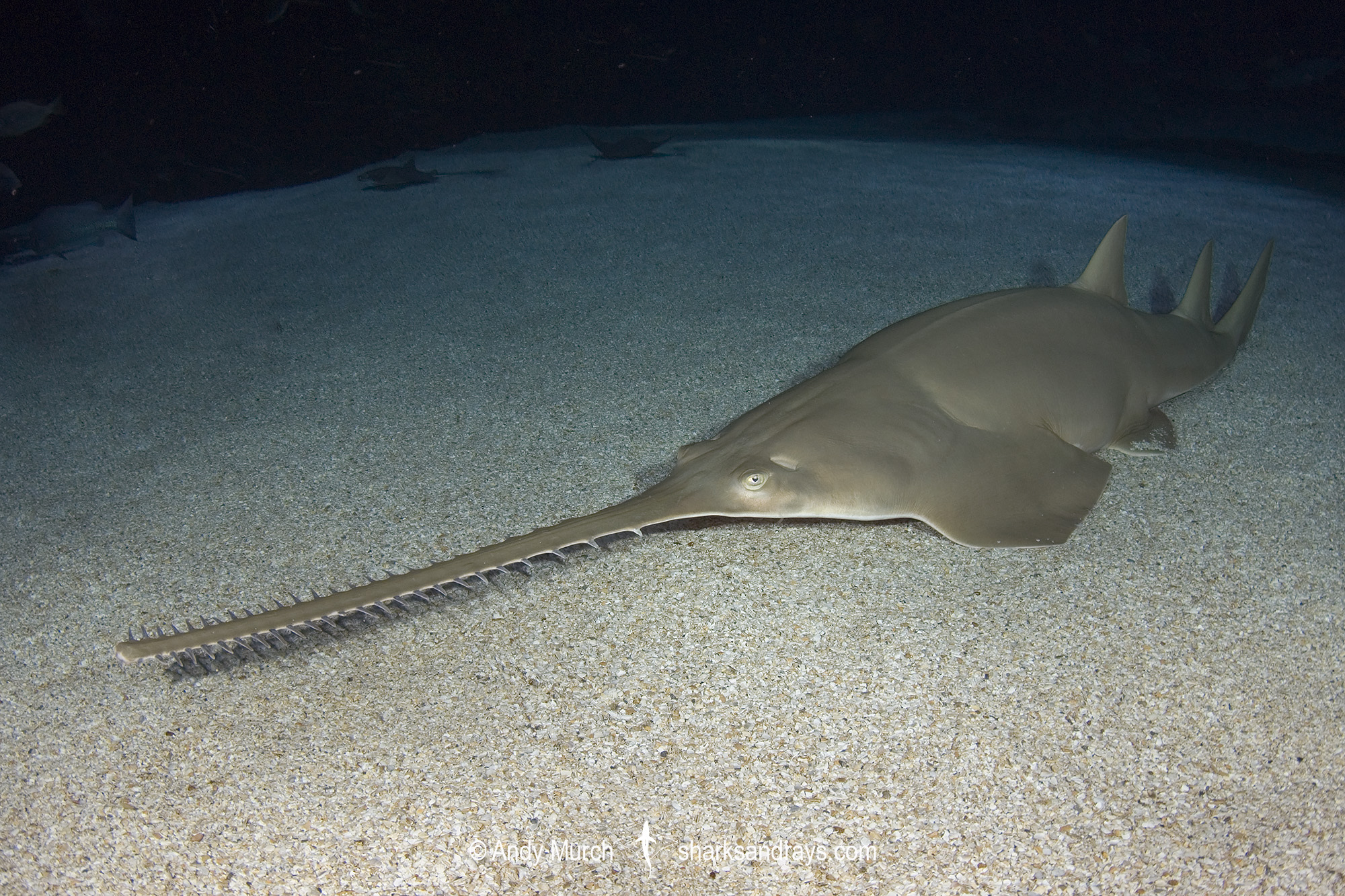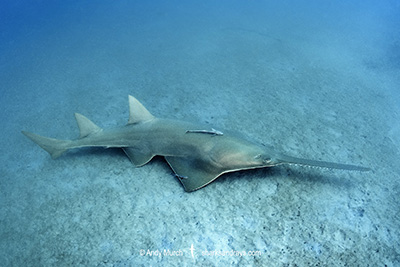Common name(s)
Smalltooth Sawfish.
Identification
An extremely large, heavy-bodied sawfish, covered with rough denticles. Rostrum long and wide, with 23-37 paired rostral teeth. Teeth closer together at rostral tip than base. Rostrum length 0.23-0.33 x total length. First dorsal fin origin significantly posterior to pelvic fin origins. Dorsal posterior margins straight or weakly concave. Pectoral fins narrow and long, anterior margins weakly convex, posterior margins straight, apices obtusely angular. Caudal fin posterior margin weakly convex in jveniles, straight in adults, without a defined lower caudal lobe. No secondary lateral keel below main caudal keel at caudal base.
Colour
Dorsum greenish-brown or olive. Ventrum White, Rostral teeth white.
Size
Maximum length 730cm. Size at birth ~80cm.
Habitat
Tropical/ warm temperate inshore habitats. The green sawfish is generally associated with mangrove and other shallow coastal and estuarine environments, but it does occur further offshore at depths exceeding 70m.
Distribution
Historically widespread in the Indian Ocean and southwestern Pacific but now rarely encountered. Possibly extinct from much of its former range Remnant populations exist in the Gulf of Arabia, Red Sea, and throughout southeast Asia and northern Australia.
Conservation Status
CRITICALLY ENDANGERED
The Green Sawfish (Pristis zijsron) has low intrinsic rates of population increase, making its resilience to fishing pressure low and its recovery from depletion slow. While the current population size and historic abundance is unknown, it is suspected as having declined in all of its range states. In Australian waters, its range has been well documented to have contracted significantly. Like all sawfishes, the toothed rostrum and demersal occurrence makes Green Sawfish extremely susceptible to capture in gillnets and demersal trawl nets. Historically, the population has been negatively affected by commercial net and trawl fisheries which operate in inshore areas throughout most of its range, the cumulative impacts of which have led to population declines. This species is now protected by no-take status in some range states (e.g. Australia, Bahrain, India), is listed on Appendix I of CITES, and is protected by some areas that are closed to fishing; but these actions alone will not be sufficient to ensure its survival in most regions. Despite a lack of quantitative data to support declines, available information indicates that populations of Green Sawfish are considerably rarer than historically across its entire range. Australia has some of the last remaining viable populations of Green Sawfish in the world, albeit at significantly reduced levels. Declines in the population are suspected to exceed 80% over three generation lengths (~44 yr), and it is possible that there has been localised extinction in a number of range states due to intensive fishing, reducing its extent of occurrence, and supporting its listing as Critically Endangered.
Citation
Simpfendorfer, C. 2013. Pristis zijsron (errata version published in 2019). The IUCN Red List of Threatened Species 2013: e.T39393A141792003. https://dx.doi.org/10.2305/IUCN.UK.2013-1.RLTS.T39393A141792003.en. Downloaded on 29 April 2021.
Reproduction
Aplacental lecithotrophic viviparous. Litter size ~12.
Diet
Probably feeds mostly on crustaceans and other benthic invertebrates.
Behavior
The green sawfish has a mostly sedentary lifestyle. Tagged animals in the Gulf of Carpenteria in Northern Australia remained in shallow water and transited less than 200m in a 24hr period.
Reaction to divers
Unknown but likely difficult to approach.
Diving logistics
Green sawfish encounters by snorkelers and divers in the wild are virtually unheard of. Northern Australia is probably the easiest place to look for this species but visibility is generally very poor and the entire region has an abundance of large, potentially dangerous saltwater crocodiles.
What’s new
View our full list of updates
Similar species
Smalltooth Sawfish Distinguishable by dorsal fin origin that is closer to pelvic fin origin.





